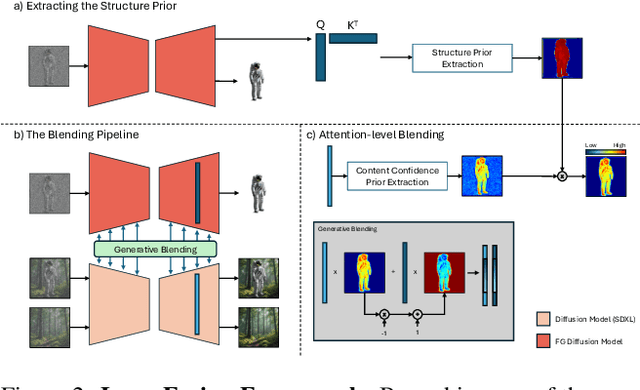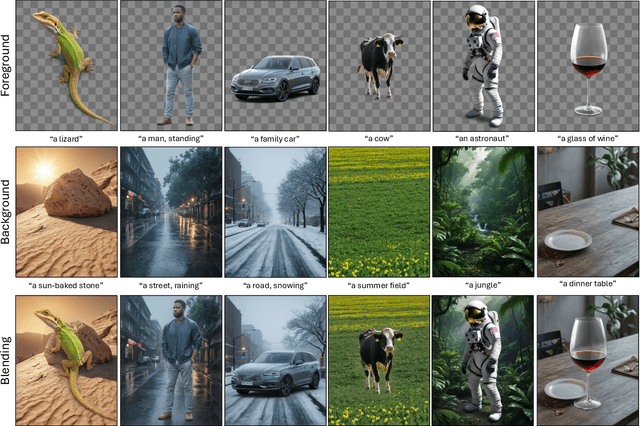Nanxuan Zhao
From Fragment to One Piece: A Survey on AI-Driven Graphic Design
Mar 24, 2025Abstract:This survey provides a comprehensive overview of the advancements in Artificial Intelligence in Graphic Design (AIGD), focusing on integrating AI techniques to support design interpretation and enhance the creative process. We categorize the field into two primary directions: perception tasks, which involve understanding and analyzing design elements, and generation tasks, which focus on creating new design elements and layouts. The survey covers various subtasks, including visual element perception and generation, aesthetic and semantic understanding, layout analysis, and generation. We highlight the role of large language models and multimodal approaches in bridging the gap between localized visual features and global design intent. Despite significant progress, challenges remain to understanding human intent, ensuring interpretability, and maintaining control over multilayered compositions. This survey serves as a guide for researchers, providing information on the current state of AIGD and potential future directions\footnote{https://github.com/zhangtianer521/excellent\_Intelligent\_graphic\_design}.
Bézier Splatting for Fast and Differentiable Vector Graphics
Mar 20, 2025Abstract:Differentiable vector graphics (VGs) are widely used in image vectorization and vector synthesis, while existing representations are costly to optimize and struggle to achieve high-quality rendering results for high-resolution images. This work introduces a new differentiable VG representation, dubbed B\'ezier splatting, that enables fast yet high-fidelity VG rasterization. B\'ezier splatting samples 2D Gaussians along B\'ezier curves, which naturally provide positional gradients at object boundaries. Thanks to the efficient splatting-based differentiable rasterizer, B\'ezier splatting achieves over 20x and 150x faster per forward and backward rasterization step for open curves compared to DiffVG. Additionally, we introduce an adaptive pruning and densification strategy that dynamically adjusts the spatial distribution of curves to escape local minima, further improving VG quality. Experimental results show that B\'ezier splatting significantly outperforms existing methods with better visual fidelity and 10x faster optimization speed.
Mean-Shift Distillation for Diffusion Mode Seeking
Feb 21, 2025Abstract:We present mean-shift distillation, a novel diffusion distillation technique that provides a provably good proxy for the gradient of the diffusion output distribution. This is derived directly from mean-shift mode seeking on the distribution, and we show that its extrema are aligned with the modes. We further derive an efficient product distribution sampling procedure to evaluate the gradient. Our method is formulated as a drop-in replacement for score distillation sampling (SDS), requiring neither model retraining nor extensive modification of the sampling procedure. We show that it exhibits superior mode alignment as well as improved convergence in both synthetic and practical setups, yielding higher-fidelity results when applied to both text-to-image and text-to-3D applications with Stable Diffusion.
EmotiCrafter: Text-to-Emotional-Image Generation based on Valence-Arousal Model
Jan 10, 2025Abstract:Recent research shows that emotions can enhance users' cognition and influence information communication. While research on visual emotion analysis is extensive, limited work has been done on helping users generate emotionally rich image content. Existing work on emotional image generation relies on discrete emotion categories, making it challenging to capture complex and subtle emotional nuances accurately. Additionally, these methods struggle to control the specific content of generated images based on text prompts. In this work, we introduce the new task of continuous emotional image content generation (C-EICG) and present EmotiCrafter, an emotional image generation model that generates images based on text prompts and Valence-Arousal values. Specifically, we propose a novel emotion-embedding mapping network that embeds Valence-Arousal values into textual features, enabling the capture of specific emotions in alignment with intended input prompts. Additionally, we introduce a loss function to enhance emotion expression. The experimental results show that our method effectively generates images representing specific emotions with the desired content and outperforms existing techniques.
MotionBridge: Dynamic Video Inbetweening with Flexible Controls
Dec 17, 2024



Abstract:By generating plausible and smooth transitions between two image frames, video inbetweening is an essential tool for video editing and long video synthesis. Traditional works lack the capability to generate complex large motions. While recent video generation techniques are powerful in creating high-quality results, they often lack fine control over the details of intermediate frames, which can lead to results that do not align with the creative mind. We introduce MotionBridge, a unified video inbetweening framework that allows flexible controls, including trajectory strokes, keyframes, masks, guide pixels, and text. However, learning such multi-modal controls in a unified framework is a challenging task. We thus design two generators to extract the control signal faithfully and encode feature through dual-branch embedders to resolve ambiguities. We further introduce a curriculum training strategy to smoothly learn various controls. Extensive qualitative and quantitative experiments have demonstrated that such multi-modal controls enable a more dynamic, customizable, and contextually accurate visual narrative.
SUGAR: Subject-Driven Video Customization in a Zero-Shot Manner
Dec 13, 2024Abstract:We present SUGAR, a zero-shot method for subject-driven video customization. Given an input image, SUGAR is capable of generating videos for the subject contained in the image and aligning the generation with arbitrary visual attributes such as style and motion specified by user-input text. Unlike previous methods, which require test-time fine-tuning or fail to generate text-aligned videos, SUGAR achieves superior results without the need for extra cost at test-time. To enable zero-shot capability, we introduce a scalable pipeline to construct synthetic dataset which is specifically designed for subject-driven customization, leading to 2.5 millions of image-video-text triplets. Additionally, we propose several methods to enhance our model, including special attention designs, improved training strategies, and a refined sampling algorithm. Extensive experiments are conducted. Compared to previous methods, SUGAR achieves state-of-the-art results in identity preservation, video dynamics, and video-text alignment for subject-driven video customization, demonstrating the effectiveness of our proposed method.
UniReal: Universal Image Generation and Editing via Learning Real-world Dynamics
Dec 10, 2024



Abstract:We introduce UniReal, a unified framework designed to address various image generation and editing tasks. Existing solutions often vary by tasks, yet share fundamental principles: preserving consistency between inputs and outputs while capturing visual variations. Inspired by recent video generation models that effectively balance consistency and variation across frames, we propose a unifying approach that treats image-level tasks as discontinuous video generation. Specifically, we treat varying numbers of input and output images as frames, enabling seamless support for tasks such as image generation, editing, customization, composition, etc. Although designed for image-level tasks, we leverage videos as a scalable source for universal supervision. UniReal learns world dynamics from large-scale videos, demonstrating advanced capability in handling shadows, reflections, pose variation, and object interaction, while also exhibiting emergent capability for novel applications.
LayerFusion: Harmonized Multi-Layer Text-to-Image Generation with Generative Priors
Dec 05, 2024



Abstract:Large-scale diffusion models have achieved remarkable success in generating high-quality images from textual descriptions, gaining popularity across various applications. However, the generation of layered content, such as transparent images with foreground and background layers, remains an under-explored area. Layered content generation is crucial for creative workflows in fields like graphic design, animation, and digital art, where layer-based approaches are fundamental for flexible editing and composition. In this paper, we propose a novel image generation pipeline based on Latent Diffusion Models (LDMs) that generates images with two layers: a foreground layer (RGBA) with transparency information and a background layer (RGB). Unlike existing methods that generate these layers sequentially, our approach introduces a harmonized generation mechanism that enables dynamic interactions between the layers for more coherent outputs. We demonstrate the effectiveness of our method through extensive qualitative and quantitative experiments, showing significant improvements in visual coherence, image quality, and layer consistency compared to baseline methods.
GroupDiff: Diffusion-based Group Portrait Editing
Sep 22, 2024



Abstract:Group portrait editing is highly desirable since users constantly want to add a person, delete a person, or manipulate existing persons. It is also challenging due to the intricate dynamics of human interactions and the diverse gestures. In this work, we present GroupDiff, a pioneering effort to tackle group photo editing with three dedicated contributions: 1) Data Engine: Since there is no labeled data for group photo editing, we create a data engine to generate paired data for training. The training data engine covers the diverse needs of group portrait editing. 2) Appearance Preservation: To keep the appearance consistent after editing, we inject the images of persons from the group photo into the attention modules and employ skeletons to provide intra-person guidance. 3) Control Flexibility: Bounding boxes indicating the locations of each person are used to reweight the attention matrix so that the features of each person can be injected into the correct places. This inter-person guidance provides flexible manners for manipulation. Extensive experiments demonstrate that GroupDiff exhibits state-of-the-art performance compared to existing methods. GroupDiff offers controllability for editing and maintains the fidelity of the original photos.
Toffee: Efficient Million-Scale Dataset Construction for Subject-Driven Text-to-Image Generation
Jun 13, 2024



Abstract:In subject-driven text-to-image generation, recent works have achieved superior performance by training the model on synthetic datasets containing numerous image pairs. Trained on these datasets, generative models can produce text-aligned images for specific subject from arbitrary testing image in a zero-shot manner. They even outperform methods which require additional fine-tuning on testing images. However, the cost of creating such datasets is prohibitive for most researchers. To generate a single training pair, current methods fine-tune a pre-trained text-to-image model on the subject image to capture fine-grained details, then use the fine-tuned model to create images for the same subject based on creative text prompts. Consequently, constructing a large-scale dataset with millions of subjects can require hundreds of thousands of GPU hours. To tackle this problem, we propose Toffee, an efficient method to construct datasets for subject-driven editing and generation. Specifically, our dataset construction does not need any subject-level fine-tuning. After pre-training two generative models, we are able to generate infinite number of high-quality samples. We construct the first large-scale dataset for subject-driven image editing and generation, which contains 5 million image pairs, text prompts, and masks. Our dataset is 5 times the size of previous largest dataset, yet our cost is tens of thousands of GPU hours lower. To test the proposed dataset, we also propose a model which is capable of both subject-driven image editing and generation. By simply training the model on our proposed dataset, it obtains competitive results, illustrating the effectiveness of the proposed dataset construction framework.
 Add to Chrome
Add to Chrome Add to Firefox
Add to Firefox Add to Edge
Add to Edge